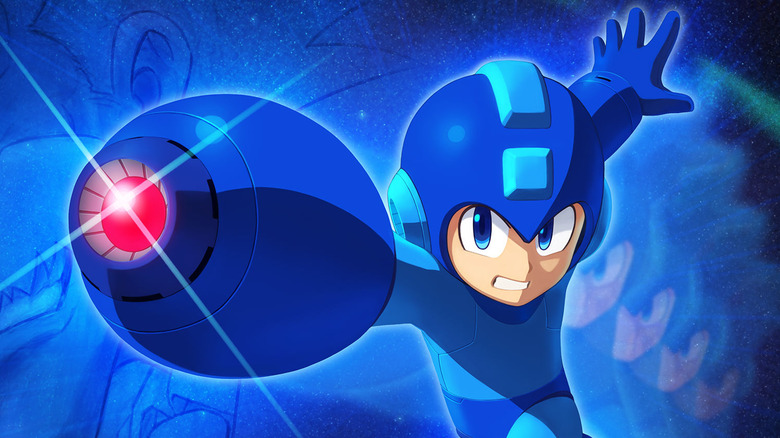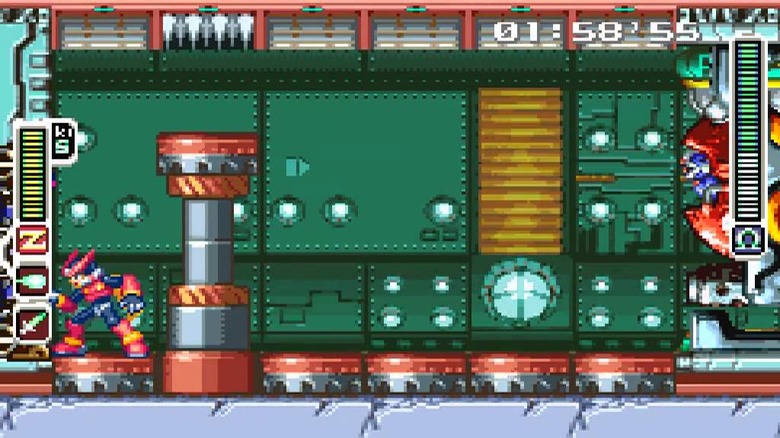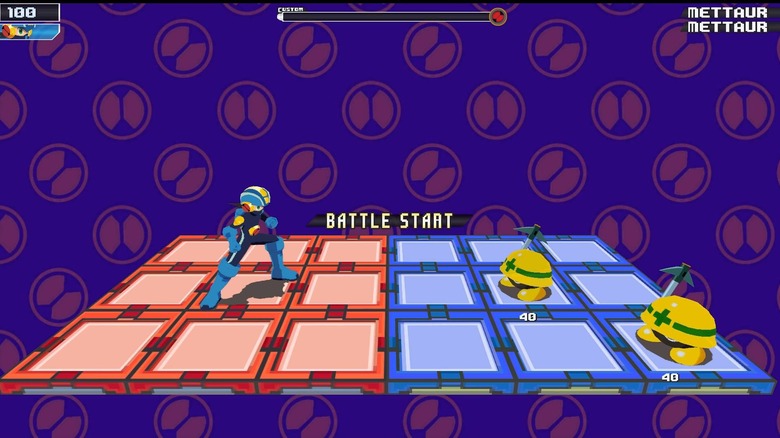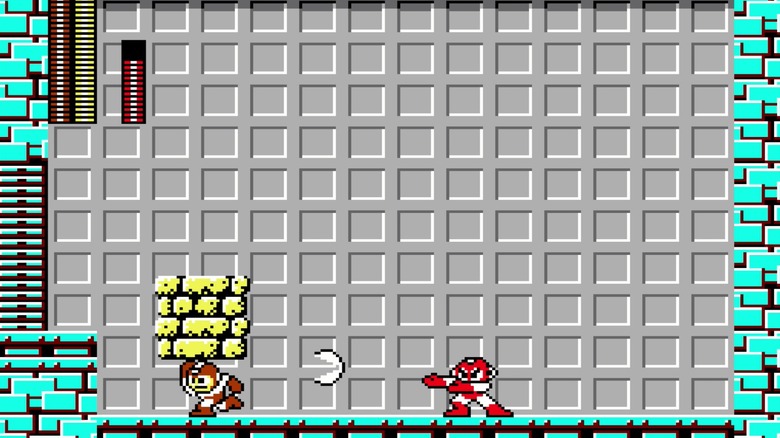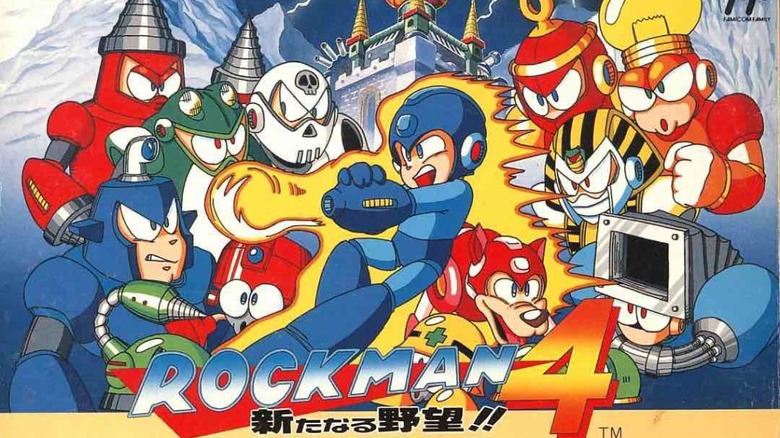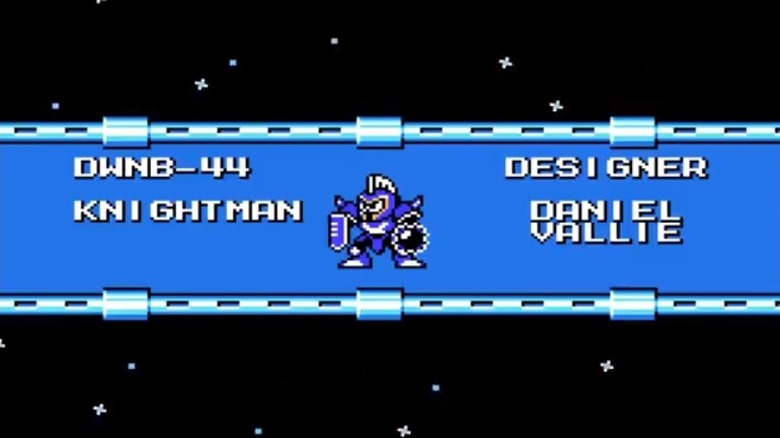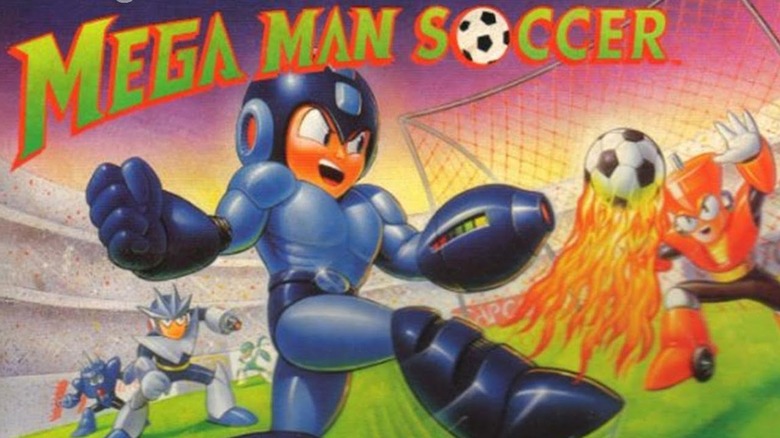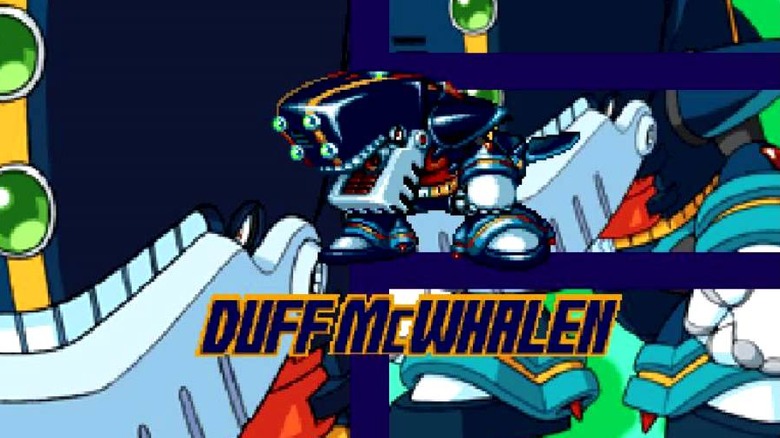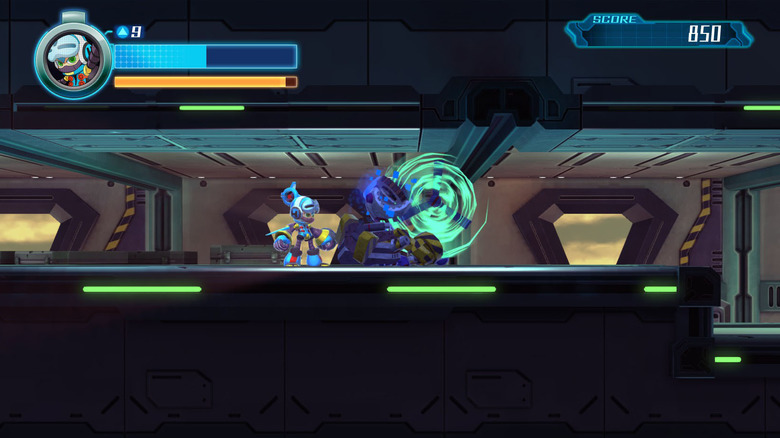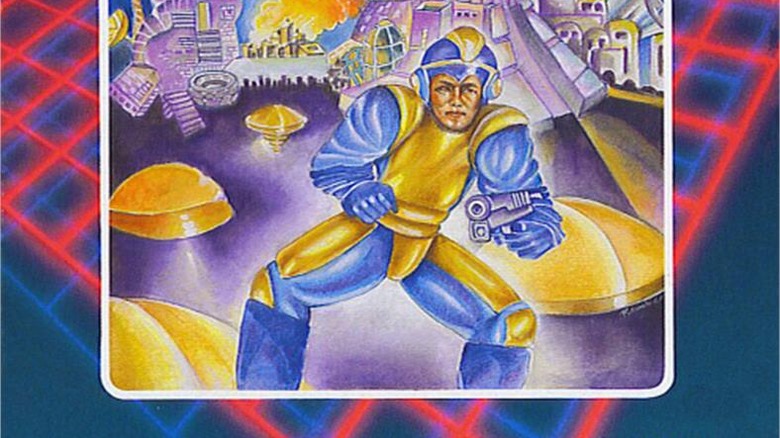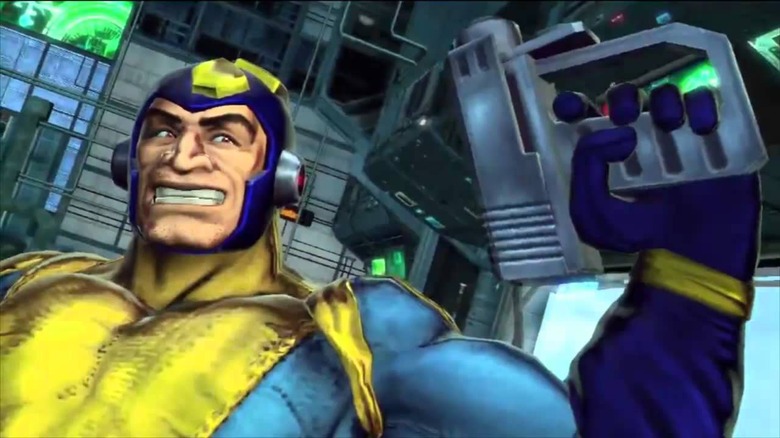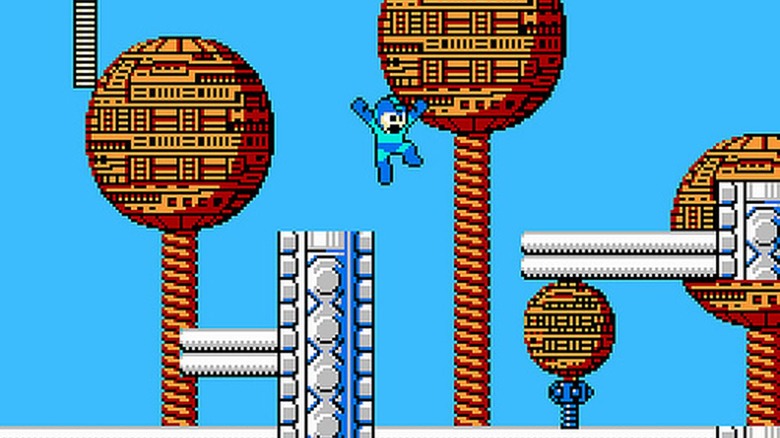The Untold Truth Of Mega Man
You'd think after over a hundred Mega Man games, the world would know all there is to know about the Blue Bomber. Not so–look past the classic robot-basting gameplay and you'll uncover more cool Mega facts than there are Dr. Wily mercy-begs. Here's what you might have never known about everyone's favorite little weapon-hoarder.
There are several series spanning thousands of years
Even those with just passing knowledge of Mega Man are aware of two main series: the original, Wily-centric version; and Mega Man X, the story of robots so advanced, they don't even need programming to attempt world domination. The robo-saga didn't end there, though. In fact, it was just getting started.
Mega Man took place in the year 20XX, which is technically the present, so expect the Robot Wars to commence any day now. Meanwhile, Mega Man X took place in 21XX, but robots blowing each other up didn't end there. About a century later, the Mega Man Zero timeline began, after a young Resistance member finds Zero (the Proto Man to X's Mega Man) sealed away in a lab. There, you fight an evil clone of X called Copy X, because if there's one thing consistent about Mega Man, it's that major characters never go away.
After that came Mega Man ZX, set a couple hundred years after Zero. At this point, robots and humans are basically the same, as humans have mechanical parts, and robots have finite life. Also, Mega Man isn't one robot, but rather anybody who can access the hilariously-named "Meta-Encapsulated Granule Awareness," or MEGA, system. Finally, we have Mega Man Legends, which takes place thousands of years after ZX, long after the last pure human died. If destroying humanity was Dr. Wily's plan all along, then a job well done, sir. You played the long game, and you won.
All this, by the way, doesn't even approach the alternate dimension games. Speaking of which...
There's two spin-off series too
As if several millennia worth of little blue robots wasn't enough, Capcom also gave us two additional Mega Man series, both with more of a turn-based RPG slant than other Mega games, and taking place in a parallel universe to the one Wily and Sigma so often failed to conquer.
Mega Man Battle Network takes place in 200X, parallel to the original Mega Man series. In this world, the internet has consumed everything–from TVs to coffee machines–which actually makes it sound kind of like our world. But we don't have anthropomorphic internet navigators like Battle's hero, Lan Hikari, does. His is conveniently named MEGAMAN.EXE, and the two travel throughout the internet, fighting destructive viruses and online terrorists together. In a shocking twist for a series all about the internet, the Big Bad is not named Troll Man.
Capcom then expanded this second Megaverse with the Mega Man Star Force series, taking place 200 years after Battle Network. Even still, there are very few references to other Mega Men, meaning it might as well be its own series. Here, you play a guy named Geo who can join forces with an alien named Omega-Xi to form Star Force Mega Man. Together, the two battle evil and search for Geo's missing father, though the full plot's far more complicated than that. The Battle Network story's not easy to describe either, meaning this extra universe is way busier than the main one–where the most complex development is Wily disguising a robot as Proto Man–could ever hope to be.
The first Mega Man flopped
Considering Mega Man has been successful for so long, it seems inconceivable he might've been unpopular at any point. Well, prepare to conceive, because the original Mega Man–the beloved classic that started it all–died quicker than Metal Man eating his own weapon.
As told by Event Hubs, the Blue Bomber's first run just didn't sell well. In the hands of most companies, that would be the end of the Mega-story, and this article would be about some other game series. But luckily for Mega Man, he was with Capcom, a company with a reputation for allowing sequel development, even when the original didn't do so hot. Mega Man's director, Akira Kitamura, wanted to make a second one, and eventually Capcom allowed it, as long as he agreed to work on other projects the company felt would make more money.
This meant Mega Man's team was working two jobs, one essentially a passion project to which everyone devoted their free time. As Keiji Inafune, Mega Man's designer (and, to many fans, the character's creator), explained, "We, of our own accord, got together, spent our own time...20-hour days to complete this, because we were making something we wanted to make." Their labors produced Mega Man II, and fortunately it became the runaway success they had envisioned. In fact, at over 1.5 million copies, it's still the best-selling Mega game to date.
Music puns everywhere
You'll never accuse the Mega Man team of being music haters. All throughout the series, especially in Japan, virtually every major character's name is a musical pun. You're never too mechanical to get funky, apparently.
The music references might be hard to understand in America, as "Mega Man" and "Proto Man" certainly aren't musical at all. But in Japan, Mega Man's name is actually "Rock"–in fact, the entire series is called Rock Man. Proto Man, meanwhile, is called "Blues" in Japan, which, if you listen to his signature whistle, makes tons of sense. This helps explain everyone else's name, from Mega Man's sister Roll (Rock 'n Roll), his dog Rush, his bird Beat, and his frenemies Bass and Treble. It's almost remarkable the developers didn't give Drs. Light and Wily first names like John and Paul.
So why did Rock Man become Mega Man for the American release? It wasn't because fans in the States don't understand music puns–it's entirely because one very powerful man hated the name. Former Capcom Senior Vice-President Joseph Morici, in an interview with '90s gaming magazine Game Players (via Engadget), admitted he thought "the title was horrible." So when he suggested Mega Man, the developers ran with it–presumably because it was either that or "don't release the game." Would Americans have responded to Rock Man like they did Mega Man? That's hard to say for sure, though based on how much we love Dwayne Johnson, probably.
Most of the Robot Masters were designed by fans
Have you ever wondered what genius came up with Quick Man or Snake Man, and who needed to be knocked upside the head for dreaming up Plant Man? As it turns out, their creators weren't professional designers–they were fans like the rest of us.
Before every game–starting with Mega Man 2 and ending with 8–Capcom would put out open calls for Robot Master ideas. The eight best would become honest-to-goodness Mega Man bosses, and the lucky fan would see their name immortalized in credits. As you can imagine, such opportunities proved extremely popular. The original contest only had 8,370 entries, but by Mega Man 3, it had expanded to 50,000. At the contests' peak, Capcom received over 220,000 submissions for Mega Man 7.
Most contests were exclusive to Japan, but Capcom eventually gave residents of North American an opportunity with Mega Man 6, and two entries were greenlit. In 2014, the Mega Man Network interviewed Daniel Vallée, the creator of Knight Man (and about eight games' worth of rejected ideas, according to him). Along with the honor of seeing his creation get blown up by the real Mega Man, Vallée received a Capcom prize package that included markers, a shirt, and a clock with Knight Man's picture that, at the time of the interview, still worked.
The bosses for Mega Man 9 and 10 appear to be made in-house, however, so you can pin the blame for Sheep Man entirely on Capcom.
Capcom sold and released an unfinished Mega Man Soccer game
In 1994, Dr. Wily's robots crashed a soccer game, replacing all the players with themselves. Mega Man rushed to the rescue, not to blow them up, but to kick a ball around with them. And thus, Mega Man Soccer was born, despite virtually nobody asking for it.
Amazingly, Mega Man Soccer's mere existence isn't the most baffling part of the story–it's that the game was blatantly unfinished, but Capcom released it anyway. According to Rockman Corner, there were tons of hints that the game wasn't the completed product fans deserved. For one thing, there was literally no ending–no end sequence, no credits, not even Mega Man holding a trophy while grinning goofily. All you get is the ability to start again–just what you always wanted.
What's more, the select screen makes it seem like you could play as Wily himself, since his icon is displayed alongside everyone else's. But for some reason, you can never select him. It's not because you had to beat him first–Capcom simply forgot to let you do it.
As it turns out, the missing ending, credits, and Playable Wily are all actually in the game (along with an unused 4-player mode), as discovered by The Cutting Room Floor. The problem is, they're inaccessible without Pro Action Replay and Game Genie codes. Having to literally hack a cartridge just to play a completed product: truly the mark of any good game.
Mega Man X5's bosses are all Guns n' Roses puns
In Japan, the Mega Man X5 bosses all had animal-based names, like normal X bosses. When the game hit English-speaking shores, however, they were suddenly named after Guns n' Roses members. We now had Robot Masters called Grizzly Slash, Axle The Red, Izzy Glow, and Dark Dizzy, among others. Even the oddly named Skiver was a Guns tribute, as rocker Michael Monroe–nicknamed "High In The Sky"–was a frequent GnR collaborator. It all seemed kind of out of left field, especially considering they hadn't really been a band for almost ten years by that point. But it was still nice to be reminded of "Paradise City" while hunting down Mavericks.
For the longest time, fans wondered who renamed the bosses, and why. Finally, in 2011, voice actress Alyson Court (X-Men's Jubilee, Resident Evil's Claire Redfield, Beetlejuice's Lydia, to name a few) took to Twitter and confessed she was the culprit. Apparently, her then-husband owned a company that localized certain Capcom games, and he let her work on X5. That's when she changed all the names to GnR references, but not because she was dancing too much with Mr. Brownstone–she did it for her husband, who loved the band. As she tweeted, "At first my hubby laughed & liked it. Then when fans started complaining he got mad at me. I meant well." But as she also pointed out, many fans now like the Guns puns, meaning her initial instinct was the right one. Next step for fans: learning to like Chinese Democracy.
The Mighty #9 Debacle
While not technically a Mega Man game, Mighty #9 featured a heroic robot with an arm cannon battling eight evil robots whose powers he could steal, and Keiji Inafune was in charge. It was meant as a spiritual successor to Capcom's series...except it wound up being an unmitigated disaster.
As recapped on Destructoid and Ars Technica, in 2013 Inafune announced Mighty #9 as a Kickstarter campaign. It reached its initial goal within days, hitting multiple stretch goals soon after. Ultimately, Inafune raised over $4 million, which only sounds like a lot, since Kickstarter took 40% of that for its share. What's more, Inafune had basically promised the world–Mighty would premiere on a whopping ten systems, there would be DLCs, generous donors would get cool gifts like an old-school game box and instruction booklet, and we'd even get a Mighty #9 cartoon. Politicians promise less than Team Mighty did.
The problem, of course, was that making the game proved harder than Inafune imagined. Mighty suffered numerous delays, until finally debuting in June 2016 to a resounding "eh." The game, while not terrible, wasn't at all what the initial hype promised. Even the gifts were underwhelming, as the manual was too big for the Japanese-style game box. Inafune wound up livestreaming an apology: "I own all the problems that came with this game and if you want to hurl insults at me, it's totally my fault. I'm the key creator. I will own that responsibility." And as you probably guessed, there is no cartoon.
The mystery of the awful early box art
The original Mega Man's American box art is the stuff of legend, presenting a character that doesn't look one speck like the hero. Clad in what looks like a blue-and-yellow snowsuit, Mega Man stands as awkwardly as possible, brandishing, of all things, a pistol. It's like whoever drew it had no idea Mega Man used an arm cannon, even though both Japan and Europe knew, judging by their (way better) box covers. To top it all off, the unknown artist made Mega Man look old and decrepit, as opposed to the plucky young kid he resembles in virtually every other appearance. And despite years of wondering, no one has yet uncovered the person responsible for this...whatever this is.
Mega Man 2's American art was little better. He's wearing all blue and looks younger, but he's still using a pistol and it looks like Dr. Light–not Wily–is commanding Crash Man to attack him. This time, however, we know who to blame. In a 2012 interview with Nintendo Age, illustrator Mark Ericksen admits he drew the box art, but he passed the blame to Capcom's then-art director. As he explained, "What we saw was this little pixelated figure...running around on the screen shooting. So I said to the art director, 'What is he shooting with?' The art director said, 'he must have a pistol because I don't see that he's got a rifle so he must have a pistol'." So the guy told Ericksen to draw a pistol, and he did. The result was certainly memorable, though not for any reason Ericksen could be proud of.
The story of "Fat Mega Man"
You'd think Capcom wouldn't ever touch "Mega Man 1 Box Art" Mega Man again. Not so, as the company's actually used him in one of their games. What's more, they somehow made him look even worse–but in the best way possible.
The crossover fighting game Street Fighter X Tekken featured tons of characters from both franchises, as well as a couple extras. One such extra was Mega Man, but he didn't look at all like the character fans have loved for decades. This Mega was old, obese, and wearing his blue-and-yellow suit from the Mega Man 1 box–and of course he's got that pistol. It's quirky enough for a weird fighter like Tekken, but almost feels like an insult to the Blue Bomber.
As it turns out, that might well have been the case. As recapped by the Mega Man Network, Street Fighter X Tekken producer Yoshinori Ono wanted to use Mega Man in his game, but also wanted to get the blessing of Mega Man producer Keiji Inafune. He didn't get it, as Inafune preferred Ono do something more original. This didn't stop Ono, since Capcom owns Mega Man–not Inafune. But presumably to both answer Inafune's challenge and silently tell him to stick it, Ono scrapped any plans for a hunky, heroic Mega Man. Instead, he designed the dumpiest, dopiest version imaginable. If Fat Mega Man wins a tournament against Tekken and Street Fighter characters, it's only because he ate the other combatants.
The Blue Bomber's only blue due to NES hardware
There's a reason Mega Man's default color is blue, and it's not just because "Blue Bomber" is catchy as hell to say. Rather, it's because that was the best color the original NES had to offer.
According to a 2004 article in Play Magazine, in the late '80s producer Keiji Inafune found himself tasked with figuring out what his new creation, Mega Man, looked like. However, because the NES hardware could only handle so much, Inafune had a limited amount of options.
Inafune explained: "Because we were using the Nintendo, we had to make it blue...you had, I think, 56 colors that you can choose from, and of that pallette [sic], the most were blue...So if you want to use the most detailed color, it would have been blue."
Obviously, Inafune used other colors for when Mega Man switched weapons, but he was still blue the majority of the time, so he rarely looked sloppy and undetailed for very long. Of course, several years later, they introduced a character actually named Blues, and so they made his default color...red. Naturally.

